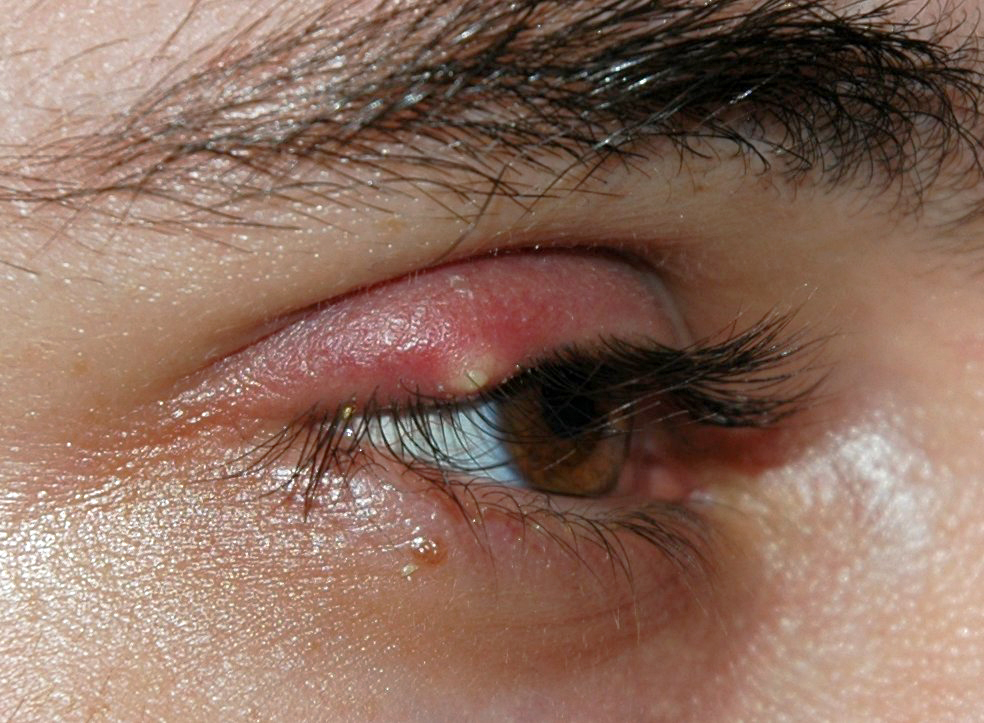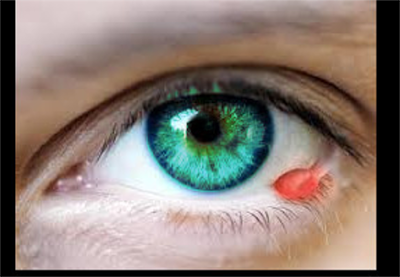Continuing Education Activity
Stye, or hordeolum, is an acute, painful infection of the eye which involves the upper or lower eyelid. Patients present with a pustule with erythema of the eyelid margin which is tender to palpation. This activity describes the evaluation and treatment of stye and reviews the role of the interprofessional team in managing patients with this condition.
Objectives:
- Identify the most common bacteria in the etiology of stye.
- Summarize the pathophysiology of stye.
- Outline the use of warm compresses and antibiotic eye ointment in the treatment of stye.
- Review the importance of improving care coordination among the interprofessional team to improve outcomes for patients affected by stye.
Introduction
A stye, also known as a hordeolum, is a common problem involving the eye seen in both primary and urgent care setting. It is a painful, acute infectious process of the upper or lower eyelid. Classically a hordeolum appears as a small pustule along the margin of the eyelid and can be differentiated from a chalazion which tends to involve less of an inflammatory response and follows a more chronic course.[1][2]
Etiology
An acute bacterial infection of the eyelid margin, 90% to 95% of cases of hordeolum are due to Staphylococcus aureus with Staphylococcus epidermidis being the second most common cause. An external hordeolum represents a localized abscess formation of the follicle of an eyelash whereas an internal hordeolum is an acute bacterial infection of the meibomian glands of the eyelid.[3][4]
A chalazion is an acute or chronic inflammation of the eyelid secondary to obstruction of oil glands (meibomian or Zeis) in the tarsal plate and a foreign body reaction to sebum. Processes that block the normal drainage of sebaceous glands, such as hordeolum, acne rosacea, and blepharitis, can contribute to the development of chalazia.
Epidemiology
While hordeola are very common, the exact incidence is unknown. Every age and demographic is affected although there is a slight increase in incidence in patients ages 30 to 50. There are no known differences in prevalence among populations worldwide. Patients with chronic conditions such as seborrhoeic dermatitis, diabetes, and high serum lipids may also be at increased risk.[5][6]
Pathophysiology
Three different glands within the eyelid are implicated in the pathogenesis of hordeolum when they become infected by S. aureus. Infection of Zeis and Moll glands (ciliary glands) causes pain and swelling at the base of the eyelash with localized abscess formation. Termed external hordeolum, these produce the typical appearance of a stye with a localized pustule of the eyelid margin. The meibomian glands are modified sebaceous glands that are found in the tarsal plate of the eyelids. They produce an oily layer on the surface of the eye that helps to maintain proper lubrication of the eye. When a meibomian gland becomes acutely infected, it results in an internal hordeolum. Due to its deeper position within the eyelid, internal hordeola have a less defined appearance than external hordeolum.
Chalazia occur secondary to mechanical obstruction and dysfunction of the meibomian gland with subsequent stasis and blockage of the release of sebum. This condition tends to be subacute to chronic and presents with a painless nodule within the eyelid or at the lid margin.
History and Physical
Usually, patients present complaining of a confined burning, tender swelling on one eyelid. Either the upper or lower lid may be involved. In some cases, the complaint may start as generalized edema and erythema of the lid that later becomes localized. Patients will frequently have a history of similar prior lesions of the eyelid. With external hordeolum, pain, edema, and swelling are localized to a discrete area of the eyelid that is tender to palpation. The stye generally appears as a pustule with mild erythema of the lid margin. Pustular exudate may be present.
Patients with internal hordeolum present with more diffuse tenderness and erythema of the lid given the relatively larger meibomian gland. Diagnosis may be made by everting the lid to reveal a small pustule of the conjunctival surface. The physical exam may appear very similar to an external hordeolum in cases when the gland is infected but without obstruction. Treatment for both internal and external hordeolum is the same, so differentiation of the two is not of significant clinical importance.
In contrast to hordeola, chalazion will have a more indolent and chronic presentation. Patients complain of non-tender nodules of the eyelid with minimal to no surrounding erythema. For persistent chalazion, chronic skin changes can develop around the underlying nodule.
Evaluation
The diagnosis of a stye (hordeolum) and chalazion requires only a history and physical exam. No diagnostic tests are required or useful in their diagnosis. Colonization with noninvasive bacteria is common, and bacterial cultures of discharge from the area usually do not correlate with clinical improvement nor aid in treatment. The clinical presentation of an acute chalazion and an internal hordeolum may be challenging to differentiate, but fortunately, management is the same.
Treatment / Management
A stye is usually a self-limiting condition with resolution occurring spontaneously within a week. Both internal and external hordeola are treated similarly. To hasten recovery and prevent the spread of infection, warm compresses and erythromycin ophthalmic ointment applied twice a day are usually sufficient treatment. There is little evidence demonstrating a benefit from the use of topical antibiotics but erythromycin ointment use for 7 to 10 days has been recommended. Warm compresses should be applied for 15 minutes at least four times a day. Gentle massage of the nodule has also been suggested to assist in the expression of the obstructed material. Oral antibiotics are rarely indicated unless there are significant surrounding erythema and a concern for periorbital cellulitis. For very large hordeola in which incision and drainage are considered, referral to an ophthalmologist is appropriate. Reevaluation within 2 to 3 days is appropriate to assess response to treatment.[7][8][9]
Conservative treatment is the mainstay of therapy for chalazia. Warm compresses and washing the affected eyelid with a gentle soap such as baby shampoo will usually be the only treatment required. Given that the etiology is inflammatory and not infectious, antibiotics are not necessary. For recurrent chalazion or those refractory to conservative treatment, corticosteroid injection into the lesion or incision and curettage may be needed. These procedures necessitate referral to an ophthalmologist. Patients with chalazia should be referred to an ophthalmologist for nonurgent evaluation.
Differential Diagnosis
- Sebaceous Gland Carcinoma
Pearls and Other Issues
Although it occurs very uncommonly, an untreated stye may evolve into a localized cellulitis of the eyelid and surrounding skin. Periorbital, or rarely, orbital cellulitis, may ensue if progression of the infection is allowed to occur. Any worsening erythema and edema beyond a localized pustule should be monitored closely for cellulitis, which may require systemic antibiotics. For infections that are not well localized, blood tests including a complete blood count (CBC) with differential and blood cultures may be needed, in addition to an orbital CT scan if orbital cellulitis is a possibility.
Blepharitis is a related condition that involves inflammation of the eyelid margin characterized by erythematous, pruritic eyelids, conjunctival injection, crusting or matting of the eyelids, and occasionally flaking of the eyelid skin. In contradistinction to hordeolum and chalazion, blepharitis should not have a discrete nodule within the eyelid. Treatment involves warm compresses, gentle washing of the eyelids with warm water or diluted baby shampoo, and if these attempts are unsuccessful, a topical antibiotic such as erythromycin.
Enhancing Healthcare Team Outcomes
A Stye may be encountered by the emergency department physician, nurse practitioner, internist or the primary care provider. Most styes can be managed conservatively by these healthcare professionals, but if there is any doubt about the diagnosis, the patient should be referred to an ophthalmologist. Styes do respond rapidly to warm compresses and erythromycin ointment. However, the patient must be seen again within 48 to 72 hours to ensure that healing is taking place.
The outcomes for most patients with a stye are excellent.[10] (Level II)


